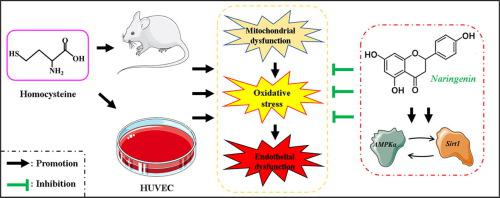Journal of Advanced Research ( IF 10.7 ) Pub Date : 2021-01-23 , DOI: 10.1016/j.jare.2021.01.009 Hui Li 1, 2 , Linlin Liu 1 , Zhiwen Cao 1 , Wen Li 1 , Rui Liu 1 , Youwen Chen 1 , Chenxi Li 1 , Yurong Song 1 , Guangzhi Liu 1 , Jinghong Hu 1 , Zhenli Liu 3 , Cheng Lu 4 , Yuanyan Liu 1

|
Introduction
Endothelial damage (ED) has been implicated in accelerating the development of atherosclerosis. The latter condition is a risk factor for developing several cardiovascular diseases (CVDs) associated with high morbidity and mortality rates worldwide.
Objectives
In our previous studies, we found naringenin (Nar), a bioactive flavanone compound, to protect against mitochondrial damage and oxidative stress. Though the pleiotropic effects of Nar have been well described, precise cytoprotective mechanisms of Nar against homocysteine (Hcy) induced ED remains elusive. Understanding these events may give an insight in to prevention and treatment of CVDs.
Methods
After ruling out the NMDA-R1 mediated pathway, RNA-Seq, a novel transcriptomic technique uncovered AMPK signaling pathway was identified as the mechanism with which Nar corrects ED. Further in vivo and in vitro tests validated the role of Nar against ED.
Results
In particular, Nar activates AMPKα/Sirt1 signaling pathway, which restores mitochondrial Ca2+ balance and ultimately lowered production of reactive oxygen species (ROS). Activated AMPKα/Sirt1 signaling pathway also up-regulates endothelial nitric oxide synthase (eNOS) activity, and then increasing the production of nitric oxide (NO), ultimately ameliorating ED.
Conclusion
Nar could increase the ROS elimination and decrease eNOS uncoupling, subsequently upregulate the NO bioavailability and endothelial function by activating AMPKα/Sirt1 signaling pathway.
中文翻译:

柚皮素通过 AMPKα/Sirt1 通路改善同型半胱氨酸诱导的内皮损伤
介绍
内皮损伤(ED)与加速动脉粥样硬化的发展有关。后一种情况是发生与全球高发病率和死亡率相关的几种心血管疾病 (CVD) 的风险因素。
目标
在我们之前的研究中,我们发现柚皮素 (Nar) 是一种具有生物活性的黄烷酮化合物,可以防止线粒体损伤和氧化应激。尽管已经很好地描述了 Nar 的多效性作用,但 Nar 对同型半胱氨酸 (Hcy) 诱导的 ED 的精确细胞保护机制仍然难以捉摸。了解这些事件可能有助于深入了解心血管疾病的预防和治疗。
方法
在排除了 NMDA-R1 介导的通路后,RNA-Seq 是一种新的转录组技术,揭示了 AMPK 信号通路,被确定为 Nar 纠正 ED 的机制。进一步的体内和体外试验验证了 Nar 对 ED 的作用。
结果
特别是,Nar 激活 AMPKα/Sirt1 信号通路,从而恢复线粒体 Ca 2+平衡并最终降低活性氧 (ROS) 的产生。激活的 AMPKα/Sirt1 信号通路还上调内皮一氧化氮合酶 (eNOS) 活性,然后增加一氧化氮 (NO) 的产生,最终改善 ED。
结论
Nar 可以增加 ROS 的消除,减少 eNOS 的解偶联,随后通过激活 AMPKα/Sirt1 信号通路上调 NO 的生物利用度和内皮功能。


























 京公网安备 11010802027423号
京公网安备 11010802027423号